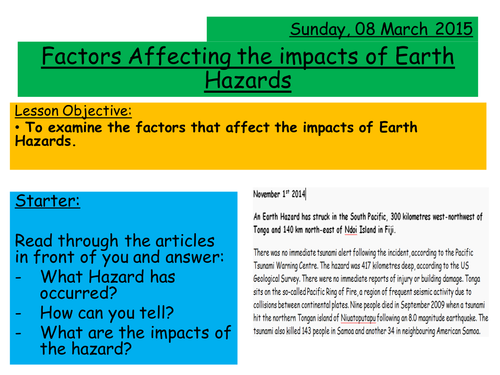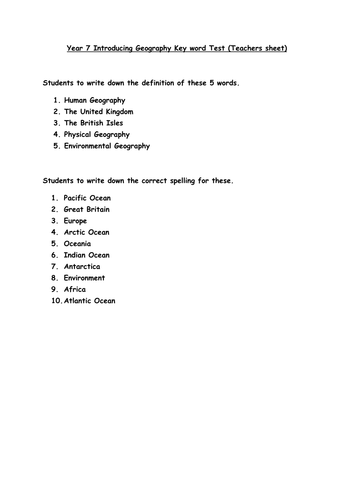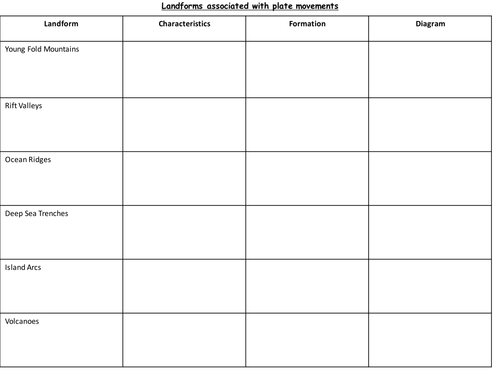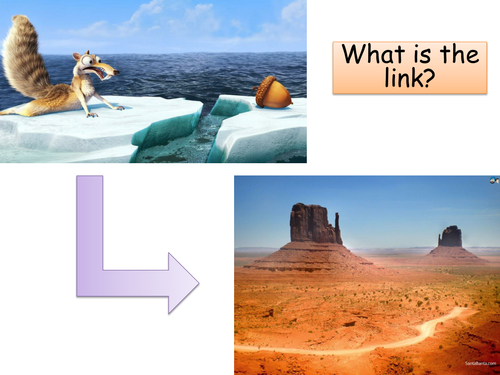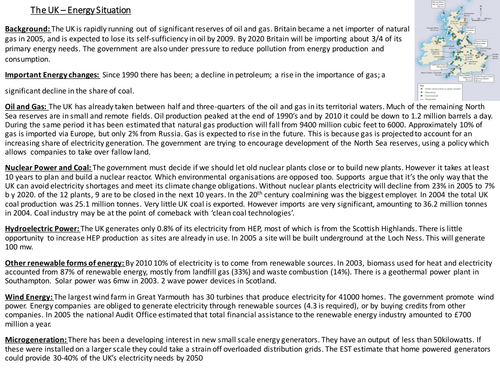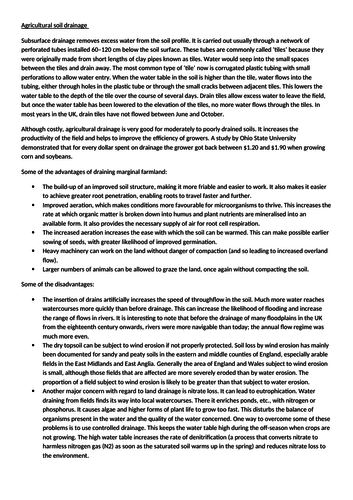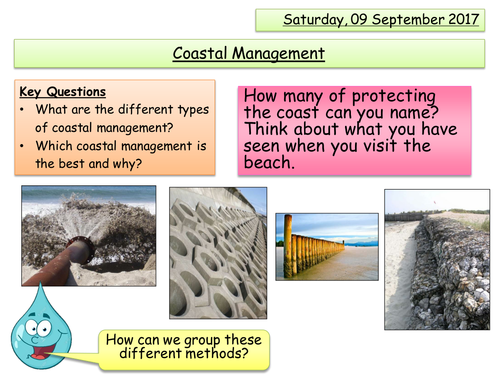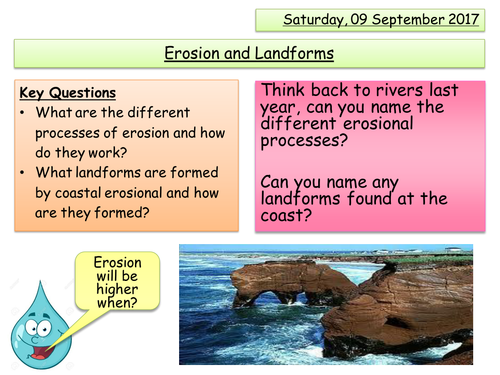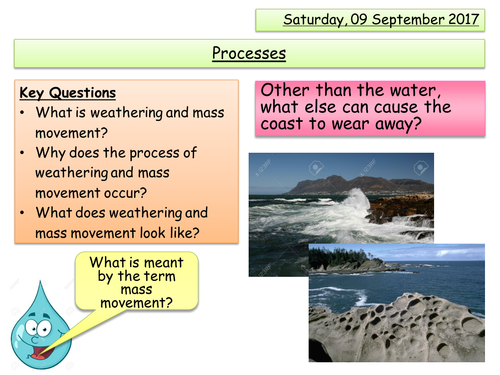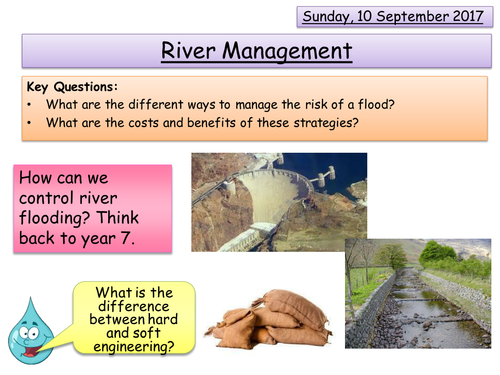
156Uploads
225k+Views
285k+Downloads
All resources

North and South Korea
This lesson is the sixth in a sequence of lessons for the topic Asia. This lesson aims to get students to think about the following:
The difference between North and South Korea
Why the countries are different and why they are now separate countries
Is reunification possible between the countries

Plate tectonics
This lessons is from the new AQA A Level specification on Hazards. This lesson looks at the early theories of plate movement, the internal structure and characteristics of the earth, and the distribution of the major tectonic plates and boundaries.

Diffusion and the Demographic Transition Model
To explain diffusion, carrying capacity, exponential growth and to be able to relate these to the demographic transition model.

Factors affecting the impacts of Earth Hazards
This resource examine the factors that affect the impacts of earth hazards.

OCR A Level River Environments Case Study Summary Sheets
Case Study Summary sheets for the River environments unit of the OCR A Level Specification. This covers: the River Tees, Thames River, Mekong, Southern England Floods, Bangladesh Floods, Managing the Thames at Oxford, Bangladesh Management and The Colorado River.

Sustainability assessment
This assessment is a decision based activity where students use their knowledge of their local area and the meaning of sustainable to choose a location for a new warehouse.
This was not levelled and is designed to give feedback to help students improve for next time. However a level criteria would be possible to create.

Plate margins and landforms
This lessons is from the new AQA A Level specification on Hazards. This lesson looks at the characteristics and origin of the earth's crust, the difference between plate margins and the formation of different landforms along these margins.

Climate Throughout History
This lesson aims to look at how the climate has changed throughout history.

Magma Plumes
This lessons is from the new AQA A Level specification on Hazards. This lesson looks at why the movement of magma is not simple, what is the theory behind magma plumes and who J T Wilson is.

OCR A Level Energy Issue Case Study Summary Sheets
Case study summary sheets that are taken from the energy issue unit of the OCR A Level specification. This covers UK, Mali, Nigeria, Norway and Germany.

Water Cycle Changes - AQA A Level
This lesson is based around the new AQA A Level specification. This is a lesson in the unit titled Water and Carbon Cycles. The main aim of this lesson is to cover the following element of the specification:
3.1.1.2 – Changes in the water cycle over time to include natural variation including storm events, seasonal changes and human impact including farming practices, land use change and water abstraction.
Any pages referenced are from the Oxford physical textbook.
Please note I do not own the rights to any of the images used in this powerpoint.

Asia's Importance
This lesson is the second in a sequence of lessons for the topic Asia. This lesson aims to get students to think about the following:
What is the global importance of Asia
What is a megacity
Then for a megacity of their choice students conduct research:
The wealth and life expectancy
The problems created
Advantages of the city
Interesting facts
If students struggle to find information I direct them to Internet Geography’s Mumbai pages

India Vs China
This lesson is the seventh in a sequence of lessons for the topic Asia. This lesson aims to get students to think about the following:
What development is
What the development of India and China area
How India and China are different

Carbon Budget - AQA A Level
This lesson is based around the new AQA A Level specification. This is a lesson in the unit titled Water and Carbon Cycles. The main aim of this lesson is to cover the following element of the specification:
3.1.1.3 – The carbon budget and the impact of the carbon cycle upon land, ocean and atmosphere, including global climate.
Any pages referenced are from the Oxford physical textbook.
Please note I do not own the rights to any of the images used in this powerpoint.

Hydrographs - AQA A Level
This lesson is based around the new AQA A Level specification. This is a lesson in the unit titled Water and Carbon Cycles. The main aim of this lesson is to cover the following element of the specification:
3.1.1.2 – The water cycle
Runoff variation and the flood hydrograph.
Any pages referenced are from the Oxford physical textbook.
Please note I do not own the rights to any of the images used in this powerpoint.

Coastal Management
This lesson aims to allow students to gain an understanding of the different ways to manage the coast. It looks at a range of soft and hard engineering strategies, and encourages students to think about the advantages and disadvantages of these strategies, before debating which of these would be the best for a particular coast (this lesson uses Southend but this can easily be changed for a different location).
By the end of the lesson students will be able to answer the following key questions:
- What are the different types of coastal management?
- Which coastal management is the best and why?

Erosional Landforms - Coasts
This lessons aims to allow students to gain an understanding of the different erosional processes that occur along the coast, followed by how these create a range of coastal landforms.
By the end of the lesson students will be able to answer the following key questions:
- What are the different processes of erosion and how do they work?
- What landforms are formed by coastal erosional and how are they formed?

Weathering and Mass Movement
This lesson aims to allow students to gain an understanding about how the processes of weathering and mass movement affect the coastline.
By the end of the lesson students will be able to answer the following key questions:
- What is weathering and mass movement?
- Why does the process of weathering and mass movement occur?
- What does weathering and mass movement look like?

River Management
This lesson is based around the new AQA GCSE specification. This is a lesson in the unit titled River landscapes in the UK. The main aim of this lesson is to cover the following element of the specification:
- The costs and benefits of the following management strategies:
* Hard engineering - dams and reservoirs, straightening, embankments, flood relief channels
* Soft engineering - flood warnings and preparation, flood plain zoning, planting trees and river restoration.




